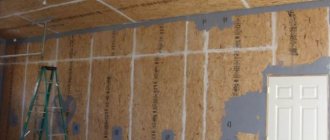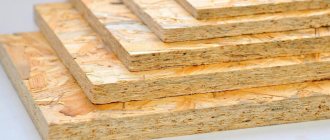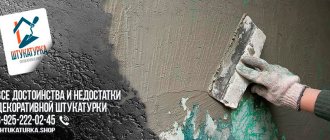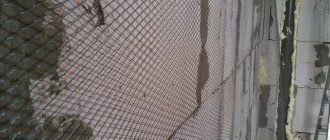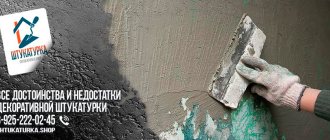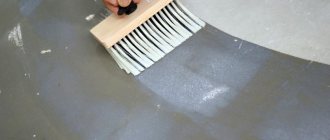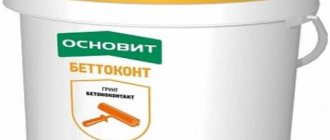The original intent of writing this detailed, practical advice-filled article is not to convince you to use acrylic primer for finishing work. The need for its use is not subject to discussion - it has been proven by practice. The problem is that the modern chemical industry produces too many varieties of acrylic primer. Here you will find both water-based and organic, and for different surfaces, and for different finishing options. It is sometimes difficult to understand all this diversity. Therefore, get a portion of useful information that, we hope, will help you avoid unnecessary expenses.
The most popular types of acrylic primers
The most widely used acrylic primer is made from an aqueous dispersion of acrylic polymer. The reason for this is its excellent performance properties:
- versatility - work effectively on a variety of types of bases;
- environmental friendliness;
- water resistance with good vapor permeability;
- good adhesive and strengthening properties;
- ease of use and cost-effectiveness;
- short drying time;
- durability.
Acrylic primers are diverse in their qualitative and quantitative set of components, and the exact recipe for most of them is not disclosed. However, the basic composition is the same and includes, in addition to acrylic dispersion:
- substances that provide viscosity (drying oils, resins);
- drying catalyst;
- excipients, fillers and special additives.
Almost all acrylic finishing materials, including acrylic primer, contain antiseptic, antifungal and anti-mold components that provide reliable biological protection.
What is the difference between acrylate and acrylic primers?
To impart special strength, elasticity and adhesion, latex emulsions are added to the acrylic primer, which partially or completely replace water. Using thick latex acrylic primers, a durable, smooth, high-quality substrate is created that maximally levels and masks surfaces. These qualities are greatly enhanced if silicone components are added, which easily form a homogeneous mixture with acrylic copolymers.
How long does it take for acrylic primer to dry on a balcony?
In addition, special admixtures can provide:
- anti-corrosion protection of metals;
- fire resistance;
- resistance to light exposure.
Depending on which functional properties dominate during application, the acrylic primer can be:
- Impregnating. Liquid transparent primer (minimum density, solid content less than 10%) of deep penetration strengthens the top layer and binds dust. Due to transparency, overlaps during application and heterogeneity are possible, which will appear in the subsequent final paint coating. There will be no obstacle to stains coming to the surface. The penetrating depth reaches 10 - 11 cm.
- Strengthening. These are thick latex primers that strengthen surfaces, improve the quality of the base by filling micropores, smoothing out unevenness and masking stains. They have a significantly lower impregnation ability, so sometimes, for porous or other problematic substrates, a preliminary stabilizing primer of deep penetration is required.
- Adhesive. Quartz primer (quartz primer) and concrete contact primer, thanks to the fractions of quartz sand or marble chips they contain, provide excellent adhesion to any surface. Indispensable for high-quality application of finishing materials on non-absorbent substrates.
- Universal. They are used most often, as they combine impregnating, adhesive, and fixing properties. As an example of a universal primer, you can take a look at the technical characteristics of the GOODHIM universal acrylic primer.
The effectiveness of using acrylic primers is limited by the shelf life (from 12 to 24 months), storage temperature and application temperature - not lower than +5 degrees and up to +30. In operation, they can withstand from -40 to +60 degrees.
Acrylic primer for wood for interior work
Attention! You should always monitor for signs that the acrylic primer has lost its suitability: abnormal thickening, delamination, clumping;
the appearance of films and stains on the surface; unpleasant putrid odor.
Tips for choosing
When choosing a material, you need to pay attention to such characteristics of acrylic primers as the amount of solids included in the mixture. The value of this indicator can be found in the product data sheet. In deep soil it should be at least 10%.
Also, before purchasing, you need to check how transparent the primer is. Typically, such material looks like a cloudy white liquid, somewhat reminiscent of milk.
Testing a primer is quite simple. It is necessary to evaluate the result when applying it with a brush to the wall. If an inconspicuous film has formed, then this is a strengthening type. Deep acrylic primer leaves no marks.
You can apply the primer in three ways - brush, roller, spray. The processing process is similar to dyeing. Here are a few main nuances:
- Buy soil according to GOST.
- It is better to treat the surface with one type of composition.
- Apply the product to a plywood or plasterboard surface preferably with a roller.
- To treat the relief surface, as well as corners and joints, you need to use a brush.
- When working with the sprayer, use personal protective equipment.
- Before applying the subsequent coating, you need to wait until the applied primer has completely dried.
The range of acrylic primers is quite wide. The best recommendation is to choose the one that best suits your situation. When going to the construction market, you must clearly understand what kind of work you need a primer for. Only then will you be able to choose the truly best one.
Where is acrylic primer used?
Acrylic primer can be used before each subsequent stage of finishing work for almost all existing bases and coatings. This is the best primer for acrylic paint and for painting with other materials.
How to dilute acrylic primer?
In addition to water-dispersion primers, there are acrylic primers based on organic solvents, the use of which is limited due to their pungent odor. They have a strengthening effect, resistance to atmospheric influences and temperature changes, microorganisms and microflora, and are resistant to pollution. This primer is also suitable for solvent-soluble acrylic paint. They are not environmentally friendly and harmless (they can cause severe allergic reactions), so only façade work is carried out with them.
If you are going to work indoors, definitely choose water-based acrylic primer.
How long does it take for deep penetration acrylic primer to dry?
Water-based acrylic primers are more environmentally friendly, odorless, and working with them does not require special protective equipment. Therefore, water mixtures are used much more often and everywhere: both for finishing facades and for interior work, when finishing walls, ceilings, and floors.
Can acrylic primer be tinted?
Types and examples of the use of acrylic primer depending on the purpose:
#1 When there are no special requirements for technical characteristics, and also when there is a heterogeneous surface, universal primers are used. They are suitable for a wide variety of surfaces (brick, fiberboard, chipboard, plastered and many others). Unfortunately, ferrous metals do not protect against oxidation.
What primer for acrylic paint?
#2 Deep penetration primers are used when it is necessary to increase moisture resistance, clog pores and bind small particles, make the surface layer stronger and level out absorbency. Deep-penetrating primers strengthen walls made of old or low-quality concrete and are good for many wood surfaces and drywall.
Which primer is better - acrylic or latex?
#3 Adhesive primers are the best option for treating poorly absorbent or completely non-absorbent surfaces (for concrete, old tiles, sand-lime brick, smooth durable coatings with paints and enamels), for plaster, for decorative wall coverings and any others. They are one of the best primer options for ceilings. Also for the floor when laying linoleum or forming a self-leveling version.
Which primer is better - acrylic or alkyd?
How to apply correctly
Acrylic primers, like other types of primers, are applied to a dry, clean, grease-free surface of walls, ceilings or floors. Such drugs are non-toxic due to the content of non-volatile active substances. They can be applied:
- With a brush. This method is the most economical, using about 80 g per m², but on large areas it is very time-consuming.
- A roller that allows you to quickly and evenly impregnate substrates made of concrete, brick, plasterboard or OSB boards. The material is consumed at the rate of approximately 100 g per m².
- With a spray gun. The most convenient method, which allows you to quickly, evenly process large areas, is well suited for processing drywall, brick and other materials. But the solution consumption is higher - depending on the type of surface it is 120-150 g per m².
- In hard-to-reach places or small areas, you can use a spatula.
How to apply correctly:
- Stir the finished mixture, dilute the concentrate with the solvent specified in the certificate in the required proportion.
- Using the selected tool, the surface of the base is well soaked, then left until completely dry. When saturating the floor, you should avoid excessive application of the composition, especially if the concentrate was diluted in a thicker proportion than indicated in the certificate. This may cause ripples and require sanding of the floor.
- How long water-dispersion compositions dry depends on the temperature and humidity of the environment. As a rule, this takes approximately 1-3 hours.
- After drying, apply a second coat, and if necessary a third, and as many more as needed.
- The surface of the floor or walls is ready for painting, wallpapering or other final finishing work.
Properly selected acrylic primers, taking into account the technical characteristics of the solution and the characteristics of the surface being treated, will ensure further quality of decorative and finishing works. Wallpaper on walls treated with a properly selected primer will lie smoothly, and the paint on the floor will not crack for a long time. The plasterboard on the walls will be protected from dampness for a long time, and the floor will delight you with its smooth, high-quality coating.
GOODHIM Products
Highly adhesive primer concrete contact GOODHIM GBK fully complies with the listed properties and promotes strong fixation of any finishing materials on smooth surfaces for a very long service life (30 years).
How much does acrylic primer cost?
Quartz primer - primer-paint GOODHIM GK also interacts well with smooth and poorly absorbent substrates, preparing them for heavy structural plasters and other finishing materials. Among other things, it reliably adheres to gypsum plasters and putties. Suitable for thermal insulation work - painting with an acrylic primer of this type does not crack due to temperature changes and protects metal parts from corrosion.
How to use acrylic primer?
Concrete contact GOODHIM GBK
Primer paint (Quartz primer) GOODHIM GK
View all products in the category
#4 Primers containing latex are better suited than others for rooms with high humidity (swimming pools, baths, bathrooms, terraces). Also, acrylic-latex primer is used where structural surfaces experience increased loads during operation (subways, airports, heated floors).
Materials such as GOODHUM GU1 primer-waterstop concentrate with an antiseptic and a high content of active latex create a water-repellent, but at the same time vapor-permeable film, even for porous materials.
GOODHIM GU1 EXTRA with a silicone modifier is even more effective in areas of high humidity. If the concentration is varied, it can be used to coat dense or porous surfaces, as well as to create a complete waterproofing (in this case, subsequent painting is not required).
Acrylic universal primer with antiseptic GOODHIM GU
Water stop soil concentrate with antiseptic GOODHIM GU 1 EXTRA (concentrate)
What is the difference between acrylic primers?
#5 There are also primers for special applications. For example, alkyd-acrylic, which works on metal and wooden surfaces, as well as plastic.
Attention! Primers containing alkyd are not recommended for use on gypsum plaster and drywall, as this may result in a fleecy surface.
All technical conditions established by Gosstandart for acrylic primers and paints are determined by GOST 52020-2003. Each manufacturer must have a certificate of conformity specifying all technical characteristics.
How to clean acrylic primer?
Advantages of acrylic compositions
The advantages of the material can be described in detail as follows:
- Versatility. Acrylic can be used to process drywall and wood, concrete, OSB boards, metal and other surfaces.
- Improved grip. The ability not only to level the base, but also to increase adhesion with any decorative surfaces that come on top.
- Weather resistance. This primer protects against environmental influences and resists any mechanical damage.
- Covering power. This means that the compositions help create a thin film on the working surface. This film is almost invisible, but is highly durable.
- Environmental Safety. When acrylic primer is made, either a natural water base or a solvent is used. But its amount in the composition is small, no more than 5-10% of other natural components. Non-volatile active substances ensure that there is no unpleasant odor during use, making the compositions suitable for interior treatment of premises. There are solvent-soluble primers, they are slightly more toxic. Recommendation for use – work outside.
- Economical. It is facilitated by low price and consumption per square meter.
Calculating the consumption of acrylic primer
To calculate the required amount of soil, it is necessary to determine the area of the surface to be treated and find out the consumption per 1 m², which is a fundamental value and is usually included in the instructions for use from the manufacturer. Moreover, many instructions indicate consumption rates depending on the surface structure.
How to dilute acrylic primer?
You can also use approximate average standards for estimation, such as in Table 1.
Table 1. Soil consumption rate for the intended surface.
However, the actual consumption rate may not coincide with that indicated in the instructions and in any table, since it depends on many subjective factors: climatic conditions, unevenness and damage to the surface, etc. The most accurate way to determine the standards is by test application on an area of 1 m².
The release form also affects the accuracy of the calculation. The easiest way is to calculate ready-made solutions. Concentrated primer and dry powders are more difficult to calculate (since everyone adjusts the consistency at their discretion). It is especially difficult to calculate consumption for soils produced in cans.
What to look for when purchasing
To ensure complete protection of the material from the adverse effects of the environment and to obtain long-term high results during final finishing, when purchasing acrylic primer, the following must be taken into account:
- Type of base. For a base consisting of dissimilar materials, a universal primer is well suited. For homogeneous walls or floors made of wood, brick or concrete, it is better to select compositions taking into account the individual characteristics of the material.
- Subsequent type of finishing. If the OSB board or wood is subsequently painted or coated with transparent varnish without color, then you should pay attention to the tinting of the mixture. If wallpaper is glued to the walls as a final covering, then the color of the primer does not matter.
- The presence of “bonus” substances that give the processed material additional properties (strengthening, fire-retardant, antiseptic, adhesive, anti-corrosion). What additional components are available and their share must be indicated in the certificate.
- Economical. As a rule, acrylic primer containing water as a solvent has a small mixture consumption per 1 m². Soils containing organic resins as a solvent are less economical; their consumption per m² will be slightly higher. The attached instructions always indicate how much material is required per 1 m².
- Type of work: external or internal (for walls outside the house an acrylic facade primer must be purchased).
- Environmentally friendly. This characteristic should be taken into account when choosing acrylate preparations for treating walls and floors in residential premises.
- How long does it take to dry? Acrylic primer, which has water or a latex base as a solvent, dries very quickly and has almost no odor.
- Availability of a quality certificate. By purchasing a cheap product on the market without a certificate, you can buy a low-quality fake, the use of which will affect the quality of subsequent work. By asking the seller for a certificate, you can protect yourself from purchasing a low-quality product.
In addition, it is worth paying attention to the release form of the drug. Acrylate primer mixtures can be sold:
- In the form of ready-made solutions, which must be mixed well before use. The certificate and instructions always indicate approximately how much of the drug is consumed when processing 1 m² of area.
- In the form of a concentrate, when the solution is brought to the required consistency immediately before use. Purchasing primer-acrylic in the form of a concentrate is much more economical and allows you to achieve the required viscosity of the product, depending on the quality of the base. The concentrate can be diluted not all, but as much as is needed for work, because it is stored longer than the finished mixture.
- In cans that need to be shaken well before use. Purchasing the soil mixture in cans ensures ease of use and low consumption per 1 m². The downside is the small volume of containers and the need to calculate how many cans you need to purchase to work on large areas. A little inconvenient when processing the floor.
Let's estimate prices
In the building materials market, prices for acrylic primers vary widely. The price is determined by:
- functional specificity of the soil itself;
- conditions dictated by the manufacturer and supplier;
- the place where the production is located;
- brand rating;
- filling with modifying additives (the more there are, the higher the price);
- Wholesale price.
That is why it is important to know the level of quality that will be necessary and sufficient for each specific case - in order to make a rational choice of primer material.
Sometimes it is still possible to make a direct calculation of the feasibility of using a primer. For example, you need to apply concrete contact to a surface that is not completely wetted. Will there be significant savings from pre-treatment with impregnating primer of the same brand? Let's summarize prices and consumption rates in Table 2.
Table 2. Acrylic primer: consumption and price.
The table shows that in the case of using a preliminary layer of deep impregnation, we have a gain in terms of the norm by 2-3 times and for deep penetration soil the price is 1.5-3 times less.
In a similar way, you can estimate the economic feasibility of deep impregnation before applying any other primer. Acrylic primer, the price of which is the most favorable, is universal without any special additives. Therefore, if the surfaces to be finished do not have any particular defects and will not bear excessive operational loads, it is better to buy it.
How long does acrylic primer take to dry?
GOODHIM GU universal acrylic primer with strong antiseptic additives, high latex content, environmentally friendly and safe for health, suitable for strengthening foundations in a wide variety of rooms, including those with high humidity. Able to bind dust, reducing water absorption, and adhere to non-absorbent substrates. It is very good from an economic point of view - the price is 200 rubles. for 5 liters.
Important! Saving primer materials should not be excessive. The primer must be applied without gaps, if necessary in several layers. Otherwise, it will not perform its functions sufficiently, which can lead to the loss of expensive finishing coatings.
